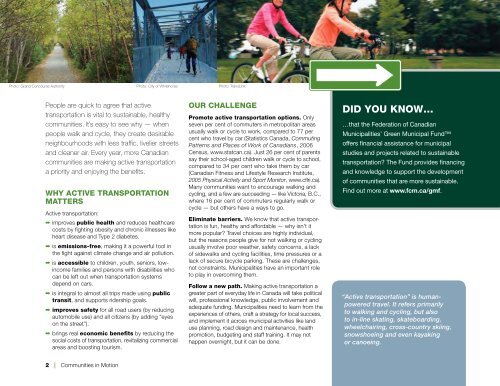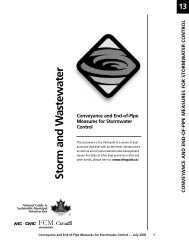Communities in Motion: Bringing Active Transportation to Life - FCM
Communities in Motion: Bringing Active Transportation to Life - FCM
Communities in Motion: Bringing Active Transportation to Life - FCM
You also want an ePaper? Increase the reach of your titles
YUMPU automatically turns print PDFs into web optimized ePapers that Google loves.
Pho<strong>to</strong>: Grand Concourse Authority<br />
People are quick <strong>to</strong> agree that active<br />
transportation is vital <strong>to</strong> susta<strong>in</strong>able, healthy<br />
communities. It’s easy <strong>to</strong> see why — when<br />
people walk and cycle, they create desirable<br />
neighbourhoods with less traffic, livelier streets<br />
and cleaner air. Every year, more Canadian<br />
communities are mak<strong>in</strong>g active transportation<br />
a priority and enjoy<strong>in</strong>g the benefits.<br />
Why active transPOrtatiOn<br />
matters<br />
<strong>Active</strong> transportation:<br />
➡ improves public health and reduces healthcare<br />
costs by fight<strong>in</strong>g obesity and chronic illnesses like<br />
heart disease and Type 2 diabetes.<br />
➡ is emissions-free, mak<strong>in</strong>g it a powerful <strong>to</strong>ol <strong>in</strong><br />
the fight aga<strong>in</strong>st climate change and air pollution.<br />
➡ is accessible <strong>to</strong> children, youth, seniors, low<strong>in</strong>come<br />
families and persons with disabilities who<br />
can be left out when transportation systems<br />
depend on cars.<br />
➡ is <strong>in</strong>tegral <strong>to</strong> almost all trips made us<strong>in</strong>g public<br />
transit, and supports ridership goals.<br />
➡ improves safety for all road users (by reduc<strong>in</strong>g<br />
au<strong>to</strong>mobile use) and all citizens (by add<strong>in</strong>g “eyes<br />
on the street”).<br />
➡ br<strong>in</strong>gs real economic benefits by reduc<strong>in</strong>g the<br />
social costs of transportation, revitaliz<strong>in</strong>g commercial<br />
areas and boost<strong>in</strong>g <strong>to</strong>urism.<br />
2 | <strong>Communities</strong> <strong>in</strong> <strong>Motion</strong><br />
Pho<strong>to</strong>: City of Whitehorse<br />
Pho<strong>to</strong>: TransL<strong>in</strong>k<br />
Our challenge<br />
Promote active transportation options. Only<br />
seven per cent of commuters <strong>in</strong> metropolitan areas<br />
usually walk or cycle <strong>to</strong> work, compared <strong>to</strong> 77 per<br />
cent who travel by car (Statistics Canada, Commut<strong>in</strong>g<br />
Patterns and Places of Work of Canadians, 2006<br />
Census, www.statcan.ca). Just 26 per cent of parents<br />
say their school-aged children walk or cycle <strong>to</strong> school,<br />
compared <strong>to</strong> 34 per cent who take them by car<br />
(Canadian Fitness and <strong>Life</strong>style Research Institute,<br />
2005 Physical Activity and Sport Moni<strong>to</strong>r, www.cflri.ca).<br />
Many communities want <strong>to</strong> encourage walk<strong>in</strong>g and<br />
cycl<strong>in</strong>g, and a few are succeed<strong>in</strong>g — like Vic<strong>to</strong>ria, B.C.,<br />
where 16 per cent of commuters regularly walk or<br />
cycle — but others have a ways <strong>to</strong> go.<br />
elim<strong>in</strong>ate barriers. We know that active transportation<br />
is fun, healthy and affordable — why isn’t it<br />
more popular? Travel choices are highly <strong>in</strong>dividual,<br />
but the reasons people give for not walk<strong>in</strong>g or cycl<strong>in</strong>g<br />
usually <strong>in</strong>volve poor weather, safety concerns, a lack<br />
of sidewalks and cycl<strong>in</strong>g facilities, time pressures or a<br />
lack of secure bicycle park<strong>in</strong>g. These are challenges,<br />
not constra<strong>in</strong>ts. Municipalities have an important role<br />
<strong>to</strong> play <strong>in</strong> overcom<strong>in</strong>g them.<br />
Follow a new path. Mak<strong>in</strong>g active transportation a<br />
greater part of everyday life <strong>in</strong> Canada will take political<br />
will, professional knowledge, public <strong>in</strong>volvement and<br />
adequate fund<strong>in</strong>g. Municipalities need <strong>to</strong> learn from the<br />
experiences of others, craft a strategy for local success,<br />
and implement it across municipal activities like land<br />
use plann<strong>in</strong>g, road design and ma<strong>in</strong>tenance, health<br />
promotion, budget<strong>in</strong>g and staff tra<strong>in</strong><strong>in</strong>g. It may not<br />
happen overnight, but it can be done.<br />
DiD yOu knOW…<br />
…that the Federation of Canadian<br />
Municipalities’ Green Municipal Fund<br />
offers f<strong>in</strong>ancial assistance for municipal<br />
studies and projects related <strong>to</strong> susta<strong>in</strong>able<br />
transportation? The Fund provides f<strong>in</strong>anc<strong>in</strong>g<br />
and knowledge <strong>to</strong> support the development<br />
of com munities that are more susta<strong>in</strong>able.<br />
F<strong>in</strong>d out more at www.fcm.ca/gmf.<br />
“<strong>Active</strong> transportation” is human-<br />
powered travel. It refers primarily<br />
<strong>to</strong> walk<strong>in</strong>g and cycl<strong>in</strong>g, but also<br />
<strong>to</strong> <strong>in</strong>-l<strong>in</strong>e skat<strong>in</strong>g, skateboard<strong>in</strong>g,<br />
wheelchair<strong>in</strong>g, cross-country ski<strong>in</strong>g,<br />
snowshoe<strong>in</strong>g and even kayak<strong>in</strong>g<br />
or canoe<strong>in</strong>g.

















